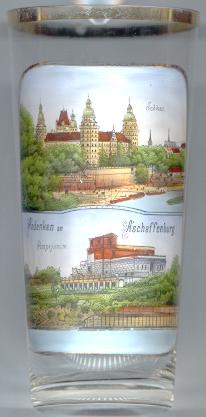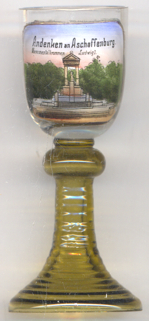

|
| DEUTSCHLAND | GERMANY |
| Bundesland: Freistaat Bayern | Bavaria |
| Regierungsbezirk: Unterfranken | |
| Landkreis: Aschaffenburg |
Aschaffenburg is situated at an elevation of 129 m in the valley of the river Main in northwest Bavaria. The first mention (as Ascis) is found in a description by the geographer of Ravenna from the 9th century about the history of the area in the 5th century AD. The first mention in modern history dates back to AD 974 and is found in a document of Emperor Otto II. At the end of the 10th century Aschaffenburg came into possession of the archdiocese of Mainz. The old castle was founded around 1220. The first known town seal dates from 1236. At the 'Aschaffenburger Fürstenversammlung' ('Aschaffenburg Assembly of Princes') in 1447 Emperor Friedrich III acknowledged Pope Nicolaus V. Distingushed mebers of this assembly were also Aeneas Silvius Piccolomini, the later Pope Pius II, and the philosopher and theologian Nikolaus von Kues. When the town participated in the uprise of the peasants during the Peasants' War 1525/1526, it was punished by the Archbishops of Mainz and lost most of its privileges. King Gustav II Adolf of Sweden conquers and loots the town during the Thirty Years' War in 1631–1634. During the early 17th century, Aschaffenburg became an important residence of the Archbishops of Mainz. When Germany's areas on the left side of the river Rhine including Mainz were lost to France 1792/1794, Aschaffenburg became the seat of the central administration of the archdiocese. The secularisation of 1803 made Aschaffenburg the capital of an independent Principality. The former Archbishop of Mainz, now Archbishop of Regensburg, Carl Theodor von Dalberg, was given the title 'Primate of the Rhine Federation' in 1806 and made Aschaffenburg his residence. The territory of this principality was given to the Kingdom of Bavaria by Napoleon in 1810. In return, Dalberg received the new Grand Duchy of Frankfurt, which included Aschaffenburg. Napoleon I visited him in Aschaffenburg in 1806, 1812 and 1813. In 1814 Aschaffenburg also became part of the Kingdom of Bavaria. The railway-line 'Ludwig-Westbahn' from Würzburg to Aschaffenburg was opened in 1854.
The famous painter, Ernst Ludwig Kirchner (1880–1938), was born in Aschaffenburg. He was one of the leaders of Expressionism and was one of the founders of the expressionist group 'Die Brücke' ('The Bridge') in 1905. He committed suicide after the Nazis had confiscated over 600 of his paintings in 1937.

The castle  Johannisburg [top] was built 1605–1614 in place of the old medieval castle by the architect Georg Ridinger. Until 1803 it was
the second residence of the Elector Archbishops of Mainz. It is one of the most important castles of the Renaissance period in Germany. At the end of the 18th century
the interor was remodelled in Classicist style by the architect Emmanuel Joseph von Herigoyen. The castle was almost completely destroyed by air raids during World War II
in 1944/1945. However, after the war restoration works began and in 1964 it was reopened as a museum.
Johannisburg [top] was built 1605–1614 in place of the old medieval castle by the architect Georg Ridinger. Until 1803 it was
the second residence of the Elector Archbishops of Mainz. It is one of the most important castles of the Renaissance period in Germany. At the end of the 18th century
the interor was remodelled in Classicist style by the architect Emmanuel Joseph von Herigoyen. The castle was almost completely destroyed by air raids during World War II
in 1944/1945. However, after the war restoration works began and in 1964 it was reopened as a museum.
The  Pompejanum [bottom] in the gardens of the castle was built in 1840–1848 by
the architect Friedrich von Gärtner for King Ludwig I of Bavaria.
It is a detailed reconstruction of a Roman villa which had been found in Pompeji. The monarch did not use it for himself but wanted it to be open for the public. After heavy
damages during World War II, the Pompejanum was reconstructed starting from 1960, and was reopened in 1994.
Pompejanum [bottom] in the gardens of the castle was built in 1840–1848 by
the architect Friedrich von Gärtner for King Ludwig I of Bavaria.
It is a detailed reconstruction of a Roman villa which had been found in Pompeji. The monarch did not use it for himself but wanted it to be open for the public. After heavy
damages during World War II, the Pompejanum was reconstructed starting from 1960, and was reopened in 1994.
In the castle, King Ludwig I of Bavaria issued the patent of nobility for his mistress, the spanish dancer Lola Montez, as Countess of Landsfeld in 1842.

The  Ludwigsbrunnen [left] is a monumental fountain in honour of King Ludwig I
of Bavaria, who had made Aschaffenburg his summer residence. The fountain was created in 1897 by the architect Paul Pfann and
architect and sculptor Ernst Pfeifer. It originally stood in the valley Schöntal.
In 1969 it was moved to its present location in Großmutterwiese.
Ludwigsbrunnen [left] is a monumental fountain in honour of King Ludwig I
of Bavaria, who had made Aschaffenburg his summer residence. The fountain was created in 1897 by the architect Paul Pfann and
architect and sculptor Ernst Pfeifer. It originally stood in the valley Schöntal.
In 1969 it was moved to its present location in Großmutterwiese.
[http://www.pressemeldung-bayern.de/aschaffenburg-ludwigsbrunnen-restauriert/]
![[scale]](lineal.jpg)